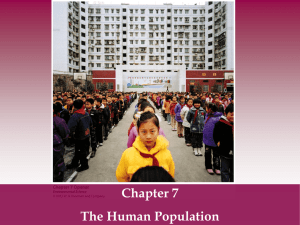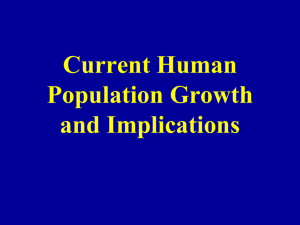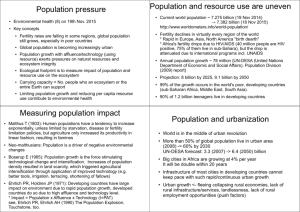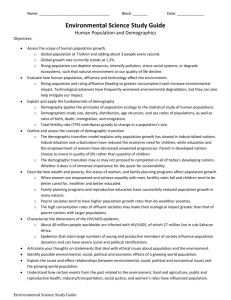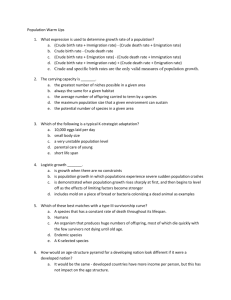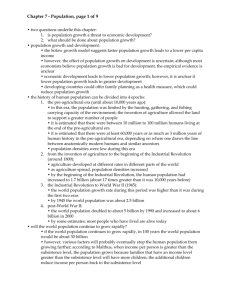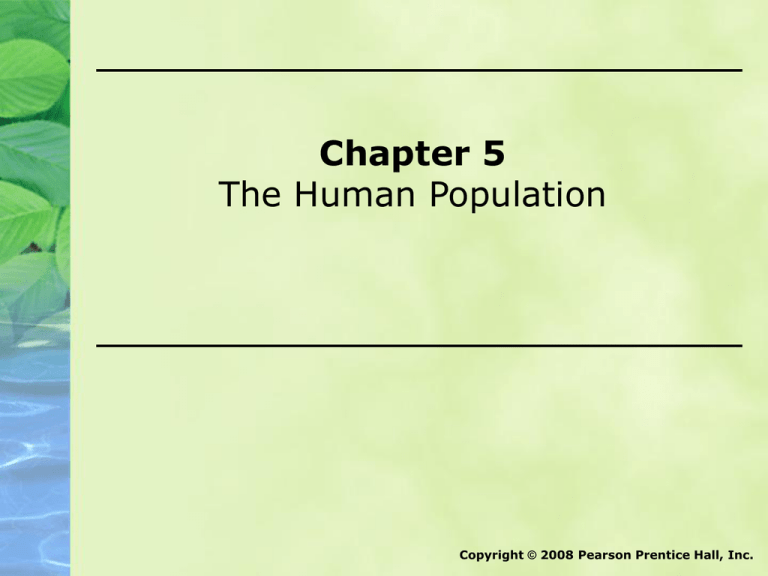
Chapter 5
The Human Population
Copyright © 2008 Pearson Prentice Hall, Inc.
5.1 - Human Population
Expansion and Its Cause
• Reasons for the patterns of growth
• Biotic potential exceeds environmental resistance:
birth rates exceed death rates
• There are 7 billion people on Earth
• If each one stood up, pronounced their name
and sat down
• It would take over 600 years to complete roll call
• By 2025 it will take 1,000 years to complete this
exercise
World Population Over the
Centuries
9,000 human beings added to the
planet every hour
Modeling Population
Growth
Human Population
Growth and Regulation I
(click to view animation)
Human Population Growth and
Regulation
Reasons for the Human
Population Explosion
•
•
•
•
•
Causes of disease recognized
Improvements in nutrition
Discovery of antibiotics
Improvements in medicine
Increase in number of women who actually
reach child-bearing age
• Short doubling times in some countries
Changing Human Survivorship
Curves: Went from B to A
A
B
Birth
Age
Death
World Population Growth and
Absolute Growth
Population Projections Based on
Different Fertility Assumptions
Gradual decline in fertility in developing countries.
2.02 children/woman
½ child lower than medium projection
½ child higher than medium projection
Maintain fertility rate
of 2.6 children/woman
Average Number of Children,
Grandchildren, and Great
Grandchildren
• America
• West Germany
• Africa
14
5
258
5.2 - Economic Categories
Based on Per Capita Gross
National Income (see Fig. 5-4)
• High-income, highly developed,
industrialized countries
• United States, Japan, Canada
• Average GNI per capita = $26,710
• Middle-income, moderately developed
countries
• Latin America, South Africa, China
• Average GNI per capita = $1,850
Economic Categories Based on
Per Capita Gross National
Income (see Fig. 5-4)
• Low-income, developing countries
• Western and central Africa, India, central
Asia
• Average GNI per capita = $430
Major Economic Divisions of the
World
Gross national income/capita
Disparities
• Developed countries
• 15% of the world’s population
• Control 80% of the world’s wealth
• Low-income developing countries
• 37% of the world’s population
• Control 3.0% of the world’s gross national
income
• Difference in per capita income:
63 to 1!
Different Populations, Different
Problems
• Human pressure on the environment
caused by three factors
• Population size
• Affluence
• Technology
Different Populations, Different
Problems
• IPAT Formula: calculates human
pressure on the environment:
I=PxAxT
•
•
•
•
I = environmental impact
P = population
A = affluence and consumptive patterns
T = level of technology in the society
Different Populations, Different
Problems
• Environmental impact of developing
countries due to “P.”
• Environmental impact of developed
countries due to “A” and “T.”
• Both have some measure of “I” for
different reasons.
• Average American places at least 20 times
the demand on Earth’s resources
compared to a person in Bangladesh.
Different Populations, Different
Problems
• How does stewardship (S) affect the
IPAT formula?
• S = wildlife conservation, pollution control,
energy conservation, and recycling
I=PxAxT
S
Population Increase in Developed
and Developing Countries
Global Conditions for a
Sustainable Population
• Lower fertility rates (stabilize
population)
• Consumption of resources must
decrease
• Protect the environment (stewardship
must increase)
Developing or Developed
Nations?
• High fertility rates
• High consumptive lifestyles: use 80% of
world’s wealth
• Intense poverty
• Eat high on the food chain
• Long doubling times
• High environmental degradation
• Twenty percent of the world’s
population
Basic Human Needs
•
•
•
•
•
•
Drinkable water
Edible food
Safe housing
Health care
An education
A job
5.3 - The Developing
Countries
• Reform the system of land ownership
• Intensify cultivation of existing land to
increase production per unit area
• Open new land to farm
• Move to cities and seek employment
• Engage in illicit activities for income
• Move to other countries
How do these “solutions” aggravate the
problems?
Growing Cities
Consequences of Exploding
Populations
More Population
Causes
deforestation
resource depletion
loss of agricultural land
biodiversity
disease
pest resistance
population migration
irrigation
loss of wetlands
Affluence in the United States
• Consume the largest share of 11 of 20
major commodities
• Eat more than three times the global
average in meat
• Lead the world in paper consumption
• Ultimately, the environment should
improve with increasing affluence and
appropriate technology.
Affluence in the United States
• Enables wealthy to clean up immediate
environment by transferring waste to
more distant locations
• Affluent isolate themselves and
unaware of the environmental stresses
caused by their consumptive lifestyles
5.4 - Population Profile United
States
Population Profile United
States
Population Profile United
States
Population Profile of Italy
Population Profile Italy
Population Projections United
States
Increased fertility rate
of 2.0 and current
migration
Fertility rate of 1.8
Population Profile Developing
Country
Population Profile Developing
Country
Population Momentum
• Effect of current age structures on
future population growth
• Determined by percent of population in
younger versus older age cohorts
Population Momentum
• It will take countries with a large base
of younger population a long time to
achieve stability.
• Countries like Iraq will continue to grow
for 50-60 years even after the total
fertility rate is reduced to replacement
level.
Pre-industrial
Transitional
Industrial
Post-industrial
Phases of Demographic
Transition
• Phase I: primitive stability (CBR = CDR)
• Phase II: declining CDR, CBR remains
high accelerating population growth
• Phase III: declining fertility rate, but
significant population growth continues
• Phase IV: modern stability with low
CBR and CDR
Demographic Transition
Comparisons (Figure 5-17)
• Phase IV: developed countries
• Phases II and III: developing countries

